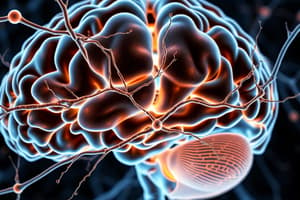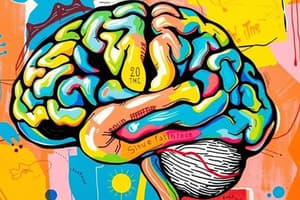Podcast
Questions and Answers
Which sense is responsible for detecting pressure, temperature, pain, and other sensations?
Which sense is responsible for detecting pressure, temperature, pain, and other sensations?
- Smell
- Taste
- Hearing
- Touch (correct)
What is the function of the retina in the visual process?
What is the function of the retina in the visual process?
- Detect taste molecules
- Interpret sound waves
- Convert light into electrical signals (correct)
- Detect pressure and temperature
Which part of the brain serves as the central processing unit in processing sensory information?
Which part of the brain serves as the central processing unit in processing sensory information?
- Cochlea
- Brain (correct)
- Cornea
- Olfactory bulb
What is the function of taste buds in the gustatory system?
What is the function of taste buds in the gustatory system?
Which part of the body converts odor molecules into electrical signals?
Which part of the body converts odor molecules into electrical signals?
How does the brain process and integrate information from our senses?
How does the brain process and integrate information from our senses?
What is the main function of the cerebral cortex?
What is the main function of the cerebral cortex?
Which part of the brain is involved in motor control and balance?
Which part of the brain is involved in motor control and balance?
What does the brainstem primarily regulate?
What does the brainstem primarily regulate?
The hypothalamus is involved in controlling which of the following?
The hypothalamus is involved in controlling which of the following?
Which part of the brain connects to the spinal cord?
Which part of the brain connects to the spinal cord?
What enables us to perceive and interact with the world?
What enables us to perceive and interact with the world?
Flashcards are hidden until you start studying
Study Notes
The Nervous System: Understanding Brain and Senses
The human nervous system is a complex and intricate network of cells that enables us to interact with our environment, think, and feel. At its core lies the brain, a powerhouse of information processing, and sensory organs, which gather and relay information to the brain. Let's delve into these essential components of this dynamic system.
The Brain
The brain is the central processing unit of the nervous system. It consists of various regions that work in harmony to perform a multitude of functions. Some key aspects of the brain include:
- Cerebral Cortex: The outer layer of the brain that is responsible for higher cognitive functions such as thinking, planning, and decision-making.
- Cerebellum: Located at the back of the brain, it's involved in motor control, balance, and coordination.
- Brainstem: The lower part of the brain that connects to the spinal cord and is responsible for autonomic functions, such as regulating heart rate and breathing.
- Hypothalamus: Sits just below the thalamus and is involved in controlling hormone production, body temperature, and appetite.
The brain communicates with the rest of the body via nerve cells (neurons) and their connections (synapses). These neurons transmit signals in the form of electrical and chemical impulses.
Senses
Our senses, also known as modalities, allow us to perceive and interact with the world. The five primary senses are:
- Sight (Vision): Light enters the eye through the cornea and is focused onto the retina, which converts light into electrical signals. These signals travel to the brain, where they are processed and interpreted as images.
- Hearing (Auditory): Sound waves enter the ear and are converted into electrical signals by the cochlea. These signals travel to the brain, where they are processed and interpreted as sound.
- Touch (Tactile): Touch receptors in the skin detect pressure, temperature, pain, and other sensations. These signals are transmitted by nerves to the spinal cord and then to the brain.
- Taste (Gustatory): Taste buds contain specialized cells that detect sweet, sour, salty, bitter, or umami (savory) tastes. These signals are transmitted by nerves to the brain.
- Smell (Olfactory): Odor molecules enter the nose and interact with specialized cells in the olfactory epithelium. These cells convert the odors into electrical signals that are transmitted to the olfactory bulb and then to the brain.
The brain processes and integrates information from all of our senses to create a coherent representation of the world around us. This allows us to make informed decisions, navigate our environment, and interact with others.
In summary, the human nervous system is a dynamic and complex network of cells that enables us to interact with and process information from our environment. The brain serves as the central processing unit, while the senses allow us to perceive and interact with the world. By understanding the structure and function of these components, we can gain a deeper appreciation for the nature of the human mind.
Studying That Suits You
Use AI to generate personalized quizzes and flashcards to suit your learning preferences.




